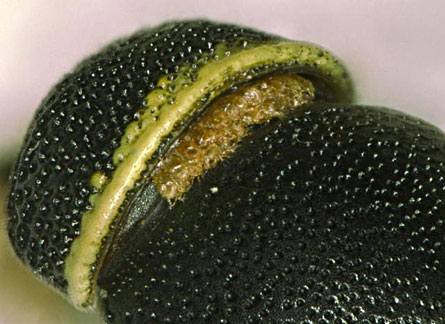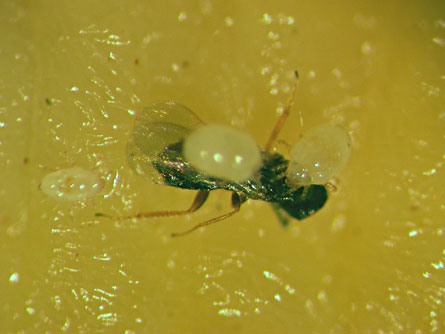- More than 2 years ago
Some parents go to extremes to protect their family — even packing heat. They ought to consider packing mites.


The mites that dwell in specialized pocketlike structures of the species of potter wasp Allodynerus delphinalis serve as bodyguards, attacking other wasps approaching the brood, reports a new study.
Researchers had thought that the relationship between the mites and the wasps was solely parasitic — the mites were seen as mooching living space and food for their young without giving anything in return. But the new research, published in the July 2 Proceedings of the Royal Society B, suggests the relationship is a mutualism, benefiting both partners.
The work suggests that some interactions have more complexity than meets the eye, and researchers should look beyond the obvious cases of mutualism, such as plant-pollinator relationships, says Kimiko Okabe, who led the new study.
“This is really interesting,” comments Barry OConnor of the University of Michigan. “The question of why various wasps go to the ‘evolutionary trouble’ of making special structures to carry mites has been long debated.” Scientists have known that the Ensliniella parasitica mites get carried around in the wasps’ peculiar pocketlike structures called acarinaria.
When these solitary wasps make nests, they lay one egg in each of several nest cavities. Then the mom wasp leaves some paralyzed food in the cavity, sealing it with a mixture of mud and saliva. Mites then move from the acarinaria into the cavities, getting some nourishment from the baby wasp’s food and also from the developing baby wasp. This doesn’t seem to hurt the young wasps, which continue to grow, even after the mite lays her own eggs in the cavity.
An intruder of more concern is the parasitic wasp Melittobia acasta, which will try to lay its eggs in the cavities built by the potter wasp. This usurpation kills the baby wasp and any baby mites. But not if the mites have anything to say about it. The mites attack any parasitic wasps trying to lay eggs in the nest, swarming the intruder, experiments by Okabe and colleague Shun’ichi Makino reveal.
“I was very surprised,” says Okabe. “This group of mites is believed to be weak and peaceful. They don’t attack any other organism.”
The mites clung to the wasps’ legs, crawled on them and probably bit them, report the researchers, both of the Forestry and Forest Products Research Institute in Ibaraki, Japan. An average of six mites could kill the intruding wasp 70 percent of the time. Ten mites always killed it.
The acarinaria on the wasp’s body are structured such that mites must enter and leave one at a time. This selectivity might give the wasp control over distribution of the mites, ensuring that each young wasp has a protective squadron, says Okabe.
If all the mites are in one cell “it’s a very dangerous situation,” says Okabe. “If you are a wasp you want a good number of mites in each cell.”





